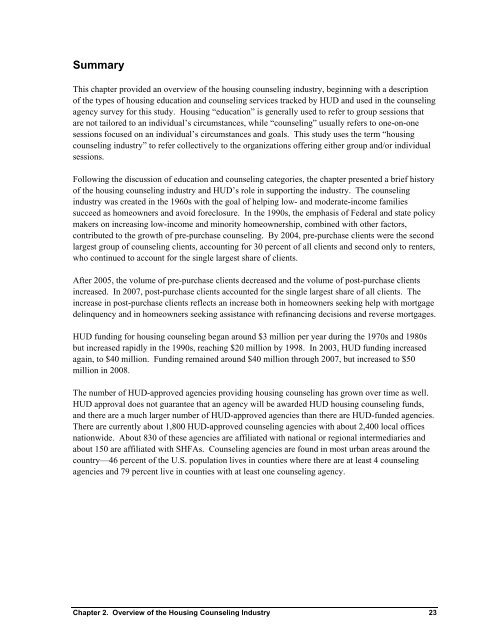Housing Counseling Process Evaluation and Design of ... - HUD User
Housing Counseling Process Evaluation and Design of ... - HUD User
Housing Counseling Process Evaluation and Design of ... - HUD User
You also want an ePaper? Increase the reach of your titles
YUMPU automatically turns print PDFs into web optimized ePapers that Google loves.
Summary<br />
This chapter provided an overview <strong>of</strong> the housing counseling industry, beginning with a description<br />
<strong>of</strong> the types <strong>of</strong> housing education <strong>and</strong> counseling services tracked by <strong>HUD</strong> <strong>and</strong> used in the counseling<br />
agency survey for this study. <strong>Housing</strong> “education” is generally used to refer to group sessions that<br />
are not tailored to an individual’s circumstances, while “counseling” usually refers to one-on-one<br />
sessions focused on an individual’s circumstances <strong>and</strong> goals. This study uses the term “housing<br />
counseling industry” to refer collectively to the organizations <strong>of</strong>fering either group <strong>and</strong>/or individual<br />
sessions.<br />
Following the discussion <strong>of</strong> education <strong>and</strong> counseling categories, the chapter presented a brief history<br />
<strong>of</strong> the housing counseling industry <strong>and</strong> <strong>HUD</strong>’s role in supporting the industry. The counseling<br />
industry was created in the 1960s with the goal <strong>of</strong> helping low- <strong>and</strong> moderate-income families<br />
succeed as homeowners <strong>and</strong> avoid foreclosure. In the 1990s, the emphasis <strong>of</strong> Federal <strong>and</strong> state policy<br />
makers on increasing low-income <strong>and</strong> minority homeownership, combined with other factors,<br />
contributed to the growth <strong>of</strong> pre-purchase counseling. By 2004, pre-purchase clients were the second<br />
largest group <strong>of</strong> counseling clients, accounting for 30 percent <strong>of</strong> all clients <strong>and</strong> second only to renters,<br />
who continued to account for the single largest share <strong>of</strong> clients.<br />
After 2005, the volume <strong>of</strong> pre-purchase clients decreased <strong>and</strong> the volume <strong>of</strong> post-purchase clients<br />
increased. In 2007, post-purchase clients accounted for the single largest share <strong>of</strong> all clients. The<br />
increase in post-purchase clients reflects an increase both in homeowners seeking help with mortgage<br />
delinquency <strong>and</strong> in homeowners seeking assistance with refinancing decisions <strong>and</strong> reverse mortgages.<br />
<strong>HUD</strong> funding for housing counseling began around $3 million per year during the 1970s <strong>and</strong> 1980s<br />
but increased rapidly in the 1990s, reaching $20 million by 1998. In 2003, <strong>HUD</strong> funding increased<br />
again, to $40 million. Funding remained around $40 million through 2007, but increased to $50<br />
million in 2008.<br />
The number <strong>of</strong> <strong>HUD</strong>-approved agencies providing housing counseling has grown over time as well.<br />
<strong>HUD</strong> approval does not guarantee that an agency will be awarded <strong>HUD</strong> housing counseling funds,<br />
<strong>and</strong> there are a much larger number <strong>of</strong> <strong>HUD</strong>-approved agencies than there are <strong>HUD</strong>-funded agencies.<br />
There are currently about 1,800 <strong>HUD</strong>-approved counseling agencies with about 2,400 local <strong>of</strong>fices<br />
nationwide. About 830 <strong>of</strong> these agencies are affiliated with national or regional intermediaries <strong>and</strong><br />
about 150 are affiliated with SHFAs. <strong>Counseling</strong> agencies are found in most urban areas around the<br />
country—46 percent <strong>of</strong> the U.S. population lives in counties where there are at least 4 counseling<br />
agencies <strong>and</strong> 79 percent live in counties with at least one counseling agency.<br />
Chapter 2. Overview <strong>of</strong> the <strong>Housing</strong> <strong>Counseling</strong> Industry 23
















